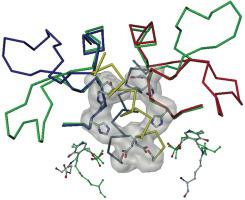Computational and Structural Biotechnology Journal ( IF 4.4 ) Pub Date : 2020-06-25 , DOI: 10.1016/j.csbj.2020.06.025 C Harder-Viddal 1 , R M Roshko 2 , J Stetefeld 3, 4, 5, 6

|
Non-equilibrium molecular dynamics simulations of vibrational energy flow induced by the imposition of a thermal gradient have been performed on the μ2-dimeric enzyme glutamate-1-semialdehyde aminomutase (GSAM), the key enzyme in the biosynthesis of chlorophyll, in order to identify energy transport pathways and to elucidate their role as potential allosteric communication networks for coordinating functional dynamics, specifically the negative cooperativity observed in the motion of the two active site gating loops. Fully atomistic MD simulations of thermal diffusion were executed with a GROMACS simulation package on a fully solvated GSAM enzyme by heating various active site target ligands (initially, catalytic intermediates and cofactors) to while holding the remainder of the protein and the solvent bath at and monitoring the temperature of all the enzyme residues as a function of time over a observation window. Energy is observed to be deposited in a relatively small number of discrete chains of residues most of which contribute to specific structural or biochemical functionality. Thermal linkages between all thermally active chains were established by isolating a specific pair of chains and performing a thermal diffusion simulation on the pair, one held at and the other at , with the rest of the protein frozen in its initial atomic configuration and thus thermally unresponsive. Proceeding in this way, it was possible to map out multiple pathways of vibrational energy flow leading from one of the active sites through a network of contiguous residues, many of which were evolutionarily conserved and linked by hydrogen bonds, into the other active site and ultimately to the other gating loop.
中文翻译:

GSAM中的能量流和亚基间信号传导:非平衡分子动力学研究。
为了确定叶绿素生物合成中的关键酶μ2-二聚酶谷氨酸-1-半醛氨基变位酶(GSAM),进行了由热梯度施加引起的振动能流的非平衡分子动力学模拟。能量传递途径并阐明其作为潜在的变构通讯网络来协调功能动力学的作用,特别是在两个活动位点门控环的运动中观察到的负协同作用。用GROMACS模拟程序包对完全溶剂化的GSAM酶进行热扩散的完全原子MD模拟,方法是将各种活性位点目标配体(最初是催化中间体和辅因子)加热到 同时将其余的蛋白质和溶剂浴保持在 并监测温度 所有酶残基随时间变化的时间 观察窗。观察到能量沉积在相对少量的残基离散链中,其中大多数残基有助于特定的结构或生化功能。通过隔离一对特定的链并在该对上进行热扩散模拟,可以建立所有热活性链之间的热键,其中一个保持在 另一个在 ,其余的蛋白质则以其初始原子构型冻结,因此对热不敏感。以这种方式进行,有可能绘制出振动能量流的多个路径,这些路径从一个活动位点通过一个连续的残基网络(其中许多是进化上保守的并通过氢键连接)进入另一个活动位点,并最终形成到另一个门控回路。











































 京公网安备 11010802027423号
京公网安备 11010802027423号